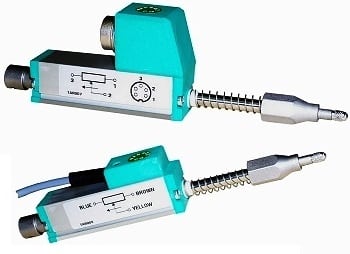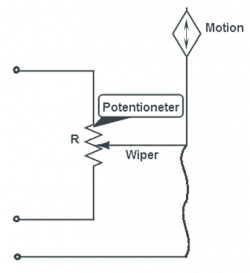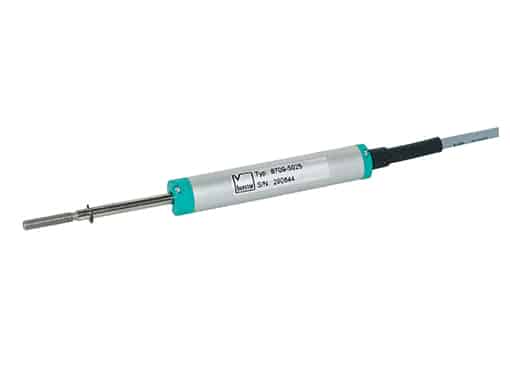
Special processes are applied to give the resistance tracks low friction, low tendency to stick or slip, resistance to abrasion and long-term stability.
Potentiometers are cost-effective devices widely used in automotive, molding machines, medical equipment, robotics, wood processing machinery, printing equipment, spraying, machine tools, sports equipment and other applications requiring precise measurement of displacement.
For more details pleases download product brochure.
| Product | Measuring range | Linearity | Resolution | Durability | Protection |
|---|---|---|---|---|---|
| 8712/8713 | 0-10mm; 0-150mm | 0.05% F.S. | 0.01mm | 100000000 operations | IP40 |
Known as a variable resister used for voltage dividing, potentiometer is the simplest type of displacement sensor that coverts a mechanical motion into an electrical signal which is proportional to the mechanical displacement.
In below figure, a voltage is applied across the resistor and a wiper of the potentiometer is moving causing changes in resistance that is directly converted to voltage and/or current signals.
 “Potentiometers comprise a resistive element, a sliding contact (wiper) that moves along the element, making good electrical contact with one part of it, electrical terminals at each end of the element, a mechanism that moves the wiper from one end to the other, and a housing containing the element and wiper.” [wikipedia]
“Potentiometers comprise a resistive element, a sliding contact (wiper) that moves along the element, making good electrical contact with one part of it, electrical terminals at each end of the element, a mechanism that moves the wiper from one end to the other, and a housing containing the element and wiper.” [wikipedia]
 “Potentiometers comprise a resistive element, a sliding contact (wiper) that moves along the element, making good electrical contact with one part of it, electrical terminals at each end of the element, a mechanism that moves the wiper from one end to the other, and a housing containing the element and wiper.” [wikipedia]
“Potentiometers comprise a resistive element, a sliding contact (wiper) that moves along the element, making good electrical contact with one part of it, electrical terminals at each end of the element, a mechanism that moves the wiper from one end to the other, and a housing containing the element and wiper.” [wikipedia] -
- Strokes on riveting machines;
-
- Spring travel measurements on axes;
-
- Length measurements on pipe bending equipment;
-
- Offset measurements on bearings;
-
- Measurement of feed, bending, deformation and press-fit displacements;
-
- Length tolerance, displacements on electromagnets;
-
- Measurement of advanced movements on pneumatic and hydraulic cylinders;
-
- Measuring wind-up and unwinding lengths;
-
- Measurements on undercarriages and dosing systems;
-
- Measurement of jointing;
-
- Determining the movement on linear axes or electric spindles.




